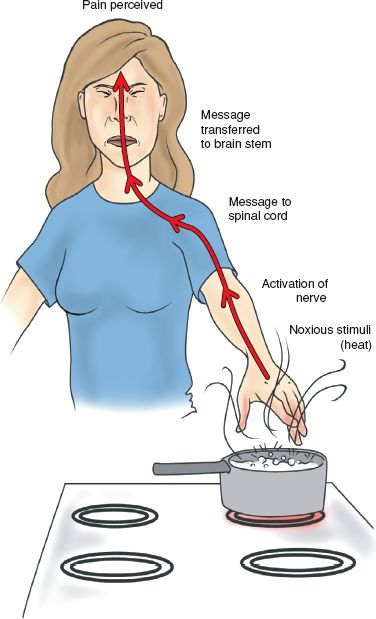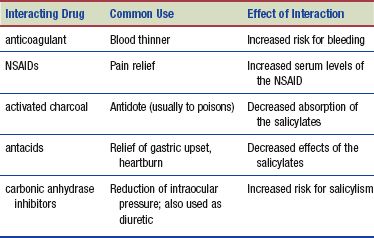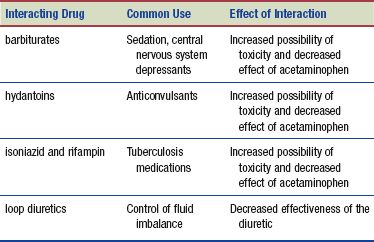DRUG CLASSES
Salicylates
Acetaminophen
Pain can be described as “the unpleasant sensory and emotional perception associated with actual or potential tissue damage” (International Association for the Study of Pain, 1979). To treat pain, both opioid and nonopioid analgesics are used. This chapter discusses a simplistic understanding of pain as well as treating pain with the nonopioid analgesics: the salicylates and acetaminophen.
Understanding Pain
The nervous system is the mechanism involved in the recognition and perception of pain. The pain perception pathway in Figure 13.1 illustrates how pain signals that noxious stimuli has or may cause injury to the body tissues. Nerve fibers in the tissue are stimulated by stretching (an example would be the swelling of a blood clot that would force the nerve to stretch) or a noxious substance, such as heat from a pan of steaming water. In the peripheral (outside or distal) tissues, the nerve endings (or receptors) are activated and send a message to the spinal cord. Here, the nerve impulses are transferred across different nerve pathways in the central nervous system and sent to the brainstem. From this area, the message goes to the brain cortex, where the perception of pain occurs, and the person should remove the hand from the heat to eliminate the pain sensation and prevent injury to the hand.
PHARMACOLOGY IN PRACTICE

Betty Peterson is at the outpatient clinic with complaints of a cold, muscular aches, and pain. She is currently taking a nonprescription aspirin product. She states she is experiencing some gastric upset and tells you that she plans to begin taking Tylenol because she has heard that it does not cause upset stomach. As you read this chapter consider whether this is a good change for Betty.

Figure 13.1 Pain perception pathway.
Defining Pain
There are several ways to define pain. Defining the duration and how the pain sensation is perceived will help you understand pain. Acute pain and chronic pain are used when discussing duration. Acute pain is brief and lasts less than 3 to 6 months. Causes range from a sunburn to postoperative, procedural, or traumatic pain. Acute pain usually subsides when the injury heals. A finger burned by the steam of hot water (as illustrated in Fig. 13.1) is an example of acute pain.
Chronic pain lasts more than 6 months and is often associated with specific diseases, such as cancer, sickle cell anemia, and end-stage organ or system failure. Various neuropathic and musculoskeletal disorders, such as headaches, fibromyalgia, rheumatoid arthritis, and osteoarthritis, are also causes of chronic pain.
The sensation of pain can be modified at the site (peripherally) when the cause is treated or by modifying the signal in the brain (centrally). Pain, such as a burned finger, can be reduced when treated at the site of injury.
The Pain Experience
To treat pain effectively, you need a good understanding of the patient’s pain experience. This is challenging, because sometimes patients feel the provider is too busy to worry about the pain, or a previous bad pain management situation will make the patient think you do not know how to treat the pain. In addition, patients sometimes offer only a vague or poor description of their pain experience. The sensation of pain is a complex phenomenon that is uniquely experienced by each individual. Therefore, the patient’s report of pain should always be taken seriously.
Medications to treat pain deal with the sensation experienced—drugs correct or help to heal the site of tissue damage or nerve stimulation (peripherally) or change or modulate the brain’s perception of the pain signal (centrally). Peripheral pain (such as a burned finger) can be treated using nonopioid analgesics. The nonopioid analgesics such as the salicylates and nonsalicylates are used for mild to moderate peripheral pain. Many of these products can be obtained without a prescription. This fact sometimes makes patients think they are harmless drugs. This chapter discusses both routine use and harmful adverse reactions of salicylates and nonsalicylate analgesics.
SALICYLATES
The salicylates are drugs derived from salicylic acid. Salicylates are useful in pain management because of their analgesic (pain-relieving), antipyretic (fever-reducing), and anti-inflammatory effects. Examples include aspirin (acetylsalicylic acid) and magnesium salicylate. Specific salicylates are listed in the Summary Drug Table: Nonopioid Analgesics: Salicylates and Nonsalicylates.
Actions
Salicylates lower body temperature by dilating peripheral blood vessels. The blood flows out to the extremities, resulting in the dissipation of the heat of fever, which in turn cools the body. The analgesic action of the salicylates is due to the inhibition of prostaglandins. Prostaglandins are found in almost every tissue of the body and body fluid. When prostaglandins are released, the sensitivity of pain receptors in the tissue increases, making the patient more likely to feel pain. Salicylates inhibit the production of prostaglandins, making pain receptors less likely to send the pain message to the brain. The reduction in prostaglandins is also thought to account for the anti-inflammatory activity of salicylates.
Aspirin more potently inhibits prostaglandin synthesis and has greater anti-inflammatory effects than other salicylates. In addition, aspirin prolongs the bleeding time by inhibiting the aggregation (clumping) of platelets. When bleeding time is prolonged, it takes a longer time for the blood to clot after a cut, surgery, or other injury to the skin or mucous membranes. Other salicylates do not have as great an effect on platelets as aspirin. This effect of aspirin on platelets is irreversible and lasts for the life of the platelet (7 to 10 days).
 HERBAL CONSIDERATIONS
HERBAL CONSIDERATIONS
Willow bark has a long history of use as an analgesic. Willow trees or shrubs grow in moist places, often along river banks in temperate or cold climates. When used as a medicinal herb, willow bark is collected in early spring from young branches. In addition to its use as a pain reliever, the bark and leaves of various willow species have been used to lower fever and reduce inflammation. The salicylates were isolated from willow bark and identified as the most likely source of the bark’s anti-inflammatory effects. The chemical structure was replicated in the laboratory and mass produced as synthetic salicylic acid. Years later, a modified version (acetylsalicylic acid) was first sold as aspirin. Aspirin became the most widely used pain reliever, fever reducer, and anti-inflammatory agent, leaving willow bark to be cast aside. The synthetic anti-inflammatory drugs work quickly and have a higher potency than willow bark. Willow bark takes longer to work and fairly high doses may be needed to achieve a noticeable effect. However, fewer adverse reactions are associated with willow bark than with the salicylates. Although adverse reactions are rare with willow bark, it should be used with caution in patients with peptic ulcers and medical conditions in which aspirin is contraindicated (DerMarderosian, 2003).
Uses
Salicylate nonopioid analgesics are used for:
• Relieving mild to moderate pain
• Reducing elevated body temperature
• Treating inflammatory conditions, such as rheumatoid arthritis, osteoarthritis, and rheumatic fever
• Decreasing the risk of myocardial infarction in those with unstable angina or previous myocardial infarction (aspirin only)
• Reducing the risk of transient ischemic attacks or strokes in men who have had transient ischemia of the brain due to fibrin platelet emboli (aspirin only). This use has been found to be effective in men (and women older than 65 years of age only).
• Helping maintain pregnancy in special at-risk populations (low-dose aspirin therapy). For example, it may be used to prevent or treat inadequate uterine–placental blood flow.
Adverse Reactions
Gastrointestinal (GI) system reactions include:
• Gastric upset, heartburn, nausea, vomiting
• Anorexia
• GI bleeding
Although salicylates are relatively safe when taken as recommended on the label or by the primary health care provider, their use can occasionally result in more serious reactions. Loss of blood through the GI tract may occur with salicylate use. The amount of blood lost is insignificant when a single dose is taken. However, use of these drugs over a long period, even in normal doses, can result in significant blood loss. Some individuals are allergic to aspirin and other salicylates. Allergy to salicylates may be manifested by hives, rash, angioedema, bronchospasm with asthma-like symptoms, and anaphylactoid (allergic) reactions.
Contraindications
Salicylates are contraindicated in patients with known hypersensitivity to salicylates or NSAIDs. Because salicylates prolong bleeding time, they are contraindicated in those with bleeding disorders or tendencies. These include patients with GI bleeding (from any cause), patients with blood dyscrasias (abnormalities), and patients receiving anticoagulant or antineoplastic drugs. Salicylates are classified as pregnancy category D (aspirin) and C drugs and should be used cautiously during pregnancy and lactation.
 LIFESPAN CONSIDERATIONS
LIFESPAN CONSIDERATIONS
Pediatric
Children or teenagers with influenza or chickenpox should not take salicylates, particularly aspirin, because their use appears to be associated with Reye’s syndrome (a life-threatening condition characterized by vomiting and lethargy progressing to coma).
Precautions
Salicylates should be used cautiously in patients during lactation and in those with hepatic or renal disease, preexisting hypoprothrombinemia (low levels of prothrombin, which hampers clotting ability), and vitamin K deficiency. The drugs are also used with caution in patients with GI irritation, such as peptic ulcers, and in patients with mild diabetes or gout.
 CHRONIC CARE CONSIDERATIONS
CHRONIC CARE CONSIDERATIONS
Aspirin is an over-the-counter (OTC) medication that patients may use to self-treat for pain. Some may take more aspirin than the recommended dosage, and toxicity can then result in a condition called salicylism. Signs and symptoms of salicylism include dizziness; tinnitus (a ringing sound in the ear); impaired hearing; nausea; vomiting; flushing; sweating; rapid, deep breathing; tachycardia; diarrhea; mental confusion; lassitude; drowsiness; respiratory depression; and coma (from large doses). Mild salicylism usually occurs with repeated administration of large doses of a salicylate. This condition is reversible with reduction of the drug dosage.
Interactions
Foods containing salicylates (e.g., curry powder, paprika, licorice, prunes, raisins, and tea) may increase the risk of adverse reactions. The following interactions may occur when a salicylate is administered with another agent:

NONSALICYLATES
The major drug classified as a nonsalicylate analgesic is acetaminophen. It is the most widely used aspirin substitute for patients who are allergic to aspirin or who experience extreme gastric upset when taking aspirin. Acetaminophen is also the drug of choice for treating children with fever and flu-like symptoms.
Actions
Acetaminophen is a nonsalicylate, nonopioid analgesic whose mechanism of action is unknown. The analgesic and antipyretic activity of acetaminophen is the same as salicylates. However, acetaminophen does not possess anti-inflammatory action and is of no value in the treatment of inflammation or inflammatory disorders (Table 13.1). Acetaminophen does not inhibit platelet aggregation; therefore, it is the analgesic of choice when bleeding tendencies are an issue.
Uses
Acetaminophen is used for:
• Treating mild to moderate pain
• Reducing elevated body temperature (fever)
• Managing pain and discomfort associated with arthritic disorders
The drug is particularly useful for those with aspirin allergy and bleeding disorders, such as bleeding ulcer or hemophilia; those receiving anticoagulant therapy; and those who have recently had minor surgical procedures.
Table 13.1 Comparison of Drug Properties

Adverse Reactions
Adverse reactions to acetaminophen are rare when the drug is used as directed. Adverse reactions associated with acetaminophen usually occur with chronic use or when the recommended dosage is exceeded. They include the following:
• Skin eruptions, urticaria (hives)
• Hemolytic anemia
• Pancytopenia (a reduction in all cellular components of the blood)
• Hypoglycemia
• Jaundice (yellow discoloration of the skin), hepatotoxicity (damage to the liver), and hepatic failure
Acute acetaminophen poisoning or toxicity can occur after a single 10- to 15-g dose of acetaminophen. Doses of 20 to 25 g may be fatal. With excessive doses, the liver cells undergo necrosis (die), and death can result from liver failure. The risk of liver failure increases in patients who drink alcohol habitually. Signs of acute acetaminophen toxicity include nausea, vomiting, confusion, liver tenderness, hypotension, cardiac arrhythmias, jaundice, and acute hepatic and renal failure.
Contraindications and Precautions
Hypersensitivity to acetaminophen is a contraindication to its use. Hepatotoxicity has occurred in habitual alcohol users after therapeutic dosages. The individual taking acetaminophen should avoid alcohol if taking more than an occasional dose of acetaminophen and avoid taking acetaminophen concurrently with the salicylates or the NSAIDs. Acetaminophen is classified as a pregnancy category B drug and is used cautiously during pregnancy and lactation. If an analgesic is necessary, it appears safe for short-term use. The drug is used cautiously in patients with severe or recurrent pain or high or continued fever because this may indicate a serious untreated illness. If pain persists for more than 5 days or if redness or swelling is present, the primary health care provider should be consulted.
 LIFESPAN CONSIDERATIONS
LIFESPAN CONSIDERATIONS
Adolescents
Many people use acetaminophen for pain relief because it does not cause GI distress. Because acetaminophen is contained in many cold preparations, the 3-gram daily maximum can be unintentionally surpassed when combining cold and pain relievers. You should instruct parents to be aware of the different drug preparations being used especially when teens and adolescents may self-administer these drugs for cold or flu symptoms. Examples of nonpain relievers containing acetaminophen are Actifed, Benadryl, Cepacol, Dayquil, Formula 44, Nyquil, Robitussin, Sudafed, and Theraflu.
Interactions
The following interactions may occur when acetaminophen is administered with another agent:

Stay updated, free articles. Join our Telegram channel

Full access? Get Clinical Tree


